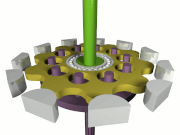A cycloidal drive or cycloidal rate reducer is a mechanism for reducing the rate of an input shaft by a particular ratio. Cycloidal speed reducers are capable of relatively high ratios in small sizes. [1]
The input shaft drives an eccentric bearing that in turn drives the cycloidal disc in an eccentric, cycloidal movement. The perimeter of this disc is geared to a stationary ring gear and has  a group of output shaft pins or rollers positioned through the facial skin of the disc. These output shaft pins directly drive the result shaft as the cycloidal disc rotates. The radial planetary gearbox motion of the disc is not translated to the result shaft.
a group of output shaft pins or rollers positioned through the facial skin of the disc. These output shaft pins directly drive the result shaft as the cycloidal disc rotates. The radial planetary gearbox motion of the disc is not translated to the result shaft.